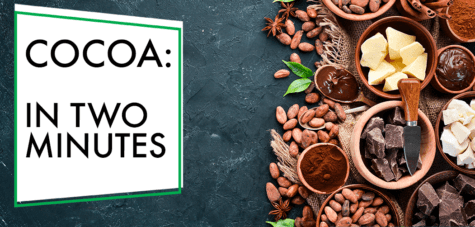Cocoa: In Two Minutes
SNAPSHOT
Cocoa is one of those blockbuster aromas that permeates childhood memories and adult culinary obsessions. Emerging from foods to beverages, gourmand notes took the fine fragrance scene by storm in the 1990’s, when Thierry Mugler launched its provocative Angel and A*Men. Dior Homme subsequently became the cocoa-based fragrance of reference, as is now Thierry Mugler’s Angel Muse for women.
IN THE FIELD
Cocoa grows in tropical regions around the world. West Africa (mostly Ivory Coast,  Ghana, Nigeria and Cameroon) is the prime growing region with over 90% of the global crop. Indonesia and Ecuador share the remaining 10%.
Ghana, Nigeria and Cameroon) is the prime growing region with over 90% of the global crop. Indonesia and Ecuador share the remaining 10%.
The Cocoa tree typically produces two dozen one-pound pods, the size of a pineapple. Each pod contains between 20 and 60 beans, each the size of a small walnut. During the one-month harvest season, pods are collected by hand and chopped opened with a machete to reveal its beans. Fresh beans are then placed in a box and allowed to “sweat” for a few days. This sweating process helps reduce the bitter taste of raw beans. Further fermentation is allowed to occur as beans are unboxed and piled under blankets for up to one week. Moist fermented beans are subsequently layed in the sun to dry. The sun-dried cocoa beans are then ready for export and further processing. In general, 1000 beans will produce 1 kilo+ of chocolate.
COCOA INGREDIENTS FOR EXTRACTION
Dried Cocoa beans are further processed for the purposes of the food and aroma industries. First, some degree of roasting is performed to achieve desired flavor profiles. Second, cocoa beans are cracked to produce two streams of raw materials, the noble bean and shells as by-product:
- Ground beans make “cocoa powder, either sold as is to consumers, or as an ingredient in food manufacturing. Extraction companies do use cocoa powder as a raw material. It quality and rich aroma content can indeed make up for cocoa powder higher cost.
- Chopped beans (aka “nibs”) are a favorite for extraction. Nibs are rich in aroma compounds and can be very cost effective. Nibs are common raw material used in water-alcohol extracts.
- Shells are considered a byproduct, for containing limited aroma in its skinny woody fibers. Nonetheless, some extraction companies do find value in cocoa shells as a low-cost raw material, and resort to petro-solvents to extract its low-yield volatile compounds.
EXTRACTION PROCESSES FOR COCOA
Multiple extraction technologies and multiple solvents can be applied to extract aroma molecules from cocoa raw materials:
- Water/Alcohol extraction: cocoa (often nibs) is bathed in a water and ethyl alcohol matrix, allowing soluble compounds to bind to the liquid matrix. The matrix is then distilled to remove the alcohol. This simple process is the most widely used for cocoa extracts
- Petro-solvent extraction: although rare, and typically targeting the needs of alcohol-based application such as fine fragrance, the process entails bathing the cocoa in a petro-solvent such as Hexane. The aromatic solution is then mixed with alcohol, chilled, dewaxed by filtration, and the alcohol is distilled off. Such process return a cocoa absolute, rich in heavy alcohol-soluble bottom-notes.
- Molecular Distillation / Distillation: This process is a secondary step to a prior extraction, to remove color. The cocoa extract, typically brownish in color is exposed to a flash distillation under vacuum. The process separates the heavy resinous and typically colored compounds from the lighter typically colorless molecules. The result is a colorless extract of value to color-sensitive beverage applications and fragrance.
Below you can see an example of one of our own extracted cocoas with mentions of the extraction processes:
[fvplayer id=”2″]
COCOA IN FLAVORS
Cocoa extracts are a mainstay of any flavorist’s palette. Pure extracts can be formulated as is or used as building blocks in combination with other cocoas of different characters to create the desired effect. Other ingredients, such as pyrazines, are also often formulated at low dosage to add a final desired final twist. Indeed, cocoa extracts come in many shades: some are sweet and chocolate powder-like, some are dark and liquorish, others are dry and ashy. Complemented w/ natural vanillin, any cocoa extract will be enhanced with a sweet lactonic character.
COCOA IN FRAGRANCE
With the 90’s marking the launch of a long era of gourmand fragrances in pop culture, cocoa extracts have a home in fragrance formulas from candles to perfume.
VIGON’s COCOA PORTFOLIO
Vigon offers a complete portfolio of cocoas, to cater to specific needs of food technologists, flavorists and perfumers. Be sure to check out our In Two Minutes evaluation videos for each of these products, available on the product pages linked below, or here on our In Two Minutes page.
505125 COCOA EXTRACT MILK CHOCOLATE (IVORY COAST BLEND)
505126 COCOA EXTRACT NATURAL COLORLESS
505129 COCOA EXTRACT RICH CHOCOLATE (IVORY COAST BLEND)


